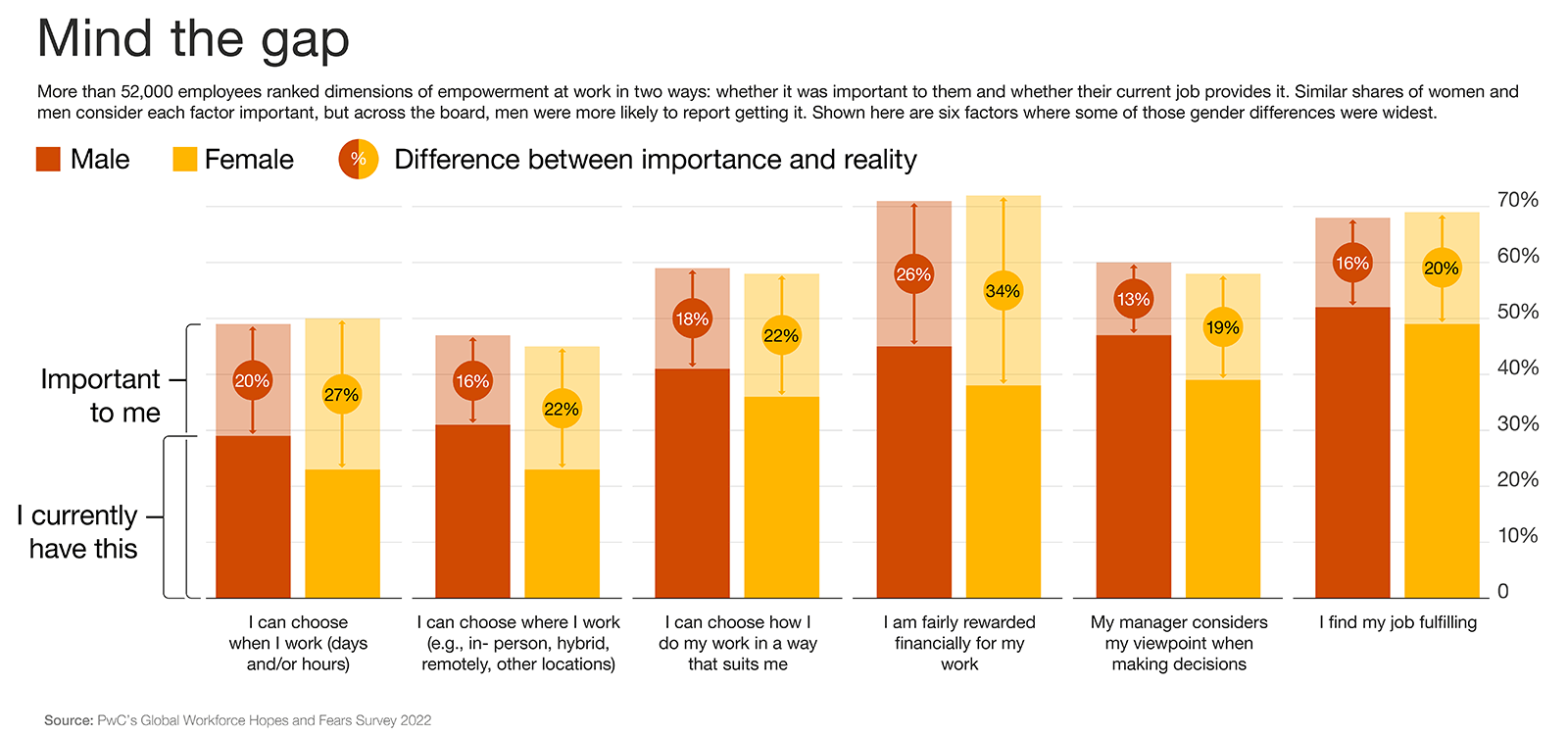Empowering women in the workplace
An analysis of employee survey data shows that at many companies, women have less autonomy and control than men. Here are five ways to create more equity.

This is the second of a series of articles looking at sentiments among key segments of the workforce, based on PwC’s Global Workforce Hopes and Fears Survey 2022. A previous article looked at the perspectives of in-person workers, and a future piece will look at younger talent.
The gender gap at companies may be narrowing, but there’s still a lot of daylight. Now, we have data to back up what most women (and many men) know at an anecdotal level: according to PwC’s Global Workforce Hopes and Fears Survey 2022, men in the workplace are more empowered than women.
The survey was conducted in March and April 2022 and drew responses from more than 52,000 workers in 44 countries, making it one of the largest workforce surveys ever conducted. Of the total base of respondents, approximately 42% were women.
As part of that survey, we wanted to know whether people felt empowered—or disempowered—at work. We looked at four well-understood dimensions of empowerment drawn from academic research: autonomy; performance/job impact; meaning and belonging; and confidence/competence. By surveying workers on these dimensions (through a total of 12 questions) and then calculating the degree to which the dimensions were both important to people and present in their work lives, we constructed a simple empowerment index, which we then used to evaluate different segments of the workforce.
When we looked at the importance of the 12 factors in our index, the responses from men and women are highly similar—typically within a few percentage points of each other. For example, when asked about being fairly rewarded financially for their work, 71% of men and 72% of women said this was important. When asked about finding their job fulfilling, 68% of men and 69% of women said it was important.
So far, so good. These findings debunk some of the outdated ideas that men and women have different expectations of their employers and careers. That should be reassuring to companies that want to create the right employee value proposition.
However, when asked about whether these factors were actually present in their current job environment, men and women showed a significant split. In all 12 of the empowerment metrics we looked at, men were more likely than women to say that those factors were present. As a result, the gap between importance and presence is bigger for women in every metric, meaning that women feel notably less empowered.
The biggest points of difference are:
• Being fairly compensated financially at work (among women, there is a gap of 34 percentage points between the share of respondents who say this is important and the share who actually experience it).
• Choosing when, where, and how to do one’s work (gaps of 27 points, 22 points, and 22 points, respectively).
• Finding one’s job fulfilling (20 points).
• Having a manager consider one’s viewpoint when making decisions (19 points).
Empowering women workers
The good news is that companies don’t have to wonder what women want in the workplace. There’s no mystery about how to improve. Instead, companies can simply give them what they say is important. To get there, companies should:
Listen and measure. Companies need a data-driven approach to solving this problem. Gender is the one dimension of diversity that can be legally measured around the world. Measure the gender proportionality of performance ratings, promotions, and key talent populations, and use predictive analytics to understand which measures will have the biggest impact in addressing inequities. In addition to gathering this data, proactively survey employees to gauge the biggest issues, the biggest unmet needs, and the biggest potential areas of improvement. Segment by geographic location and business unit or function. Conduct these assessments regularly over time, to establish a baseline for comparison.
Make pay schemes fair. The key word regarding financial compensation is fairly—women aren’t insisting on making more money than men. The bigger factor in creating empowerment is a sense that pay schemes are fair, they reward merit, and they’re reasonably free from bias. The challenge for companies is particularly acute amid the current talent shortages, when people with critical experience can name their salary. Gather and report data about salaries, bonuses, and any other compensation, to increase transparency. Measure and correct any inequities in pay, communicate those changes, and ensure that your response to the great resignation doesn’t exacerbate gender-related pay gaps.
The bigger factor in creating empowerment for women is a sense that pay schemes are fair, they reward merit, and they’re reasonably free from bias.
Boost flexibility. Give all workers greater say over their schedules, and empower them to make more decisions about how and where they accomplish their work. The shift to hybrid and remote work could either solidify gender disparities in worker autonomy or—ideally—allow companies to reset policies to put women on an equal footing with men.
Build inclusive leadership skills among managers and the senior team. Invest in bias training. Even though companies are making progress in terms of gender equality, they can move faster with structured support and training for managers and executives. In particular, the right training can help leaders understand the unconscious biases that distort their people and business decisions.
Beyond understanding the implications of potential biases, inclusive leadership means showing empathy, appreciation, and respect for every individual’s unique lived experience, while fostering an environment of psychological safety in which everyone feels empowered to speak up. Inclusive leaders are equipped to harness the power of diversity and bring out the best in diverse teams to deliver innovation and impact. Employers need to recognize the importance of inclusive leadership and foster it in their managers and executives.
Retain the lessons of the pandemic: flexible work boosts inclusivity. Last, employees have been better able to balance work, family, and personal responsibilities over the past few years because of hybrid and remote work. As some organizations consider bringing people back to the office full-time, they need to understand the ramifications for women. Such a move risks reverting to outdated biases, in which career growth and compensation increases are more likely for in-person workers. The importance of flexible work on inclusivity was a key lesson from the pandemic. Failure to learn this lesson could trigger a strong negative reaction from women.
The data is unmistakable. Women still face systemic obstacles in the workplace, and they are less empowered as a result. Business leaders that want to correct this do not need to reinvent the wheel. As our data shows, women and men value the same attributes at work. Companies simply need to ensure that those attributes are fairly distributed, regardless of an employee’s gender.
Author profiles:
- Bhushan Sethi is the joint global leader of PwC’s people and organization practice. Based in New York, he is a principal with PwC US. He is an adjunct professor at New York University’s Leonard N. Stern School of Business.
- Peter Brown is the joint global leader of PwC’s people and organization practice. He has more than 20 years of experience helping large multinational corporations redefine the way work gets done and create innovative talent ecosystems that build enabled and agile workforces. Based in London, he is a partner with PwC UK.
- Chaitali Mukherjee is PwC’s people and organization leader in India. Based in Gurgaon, she is a partner with PwC India.
- Aoife Flood specializes in diversity, strategy, upskilling, and awareness as a member of PwC's global inclusion and diversity team. Based in Dublin she is a senior manager with PwC Ireland (Republic of).




